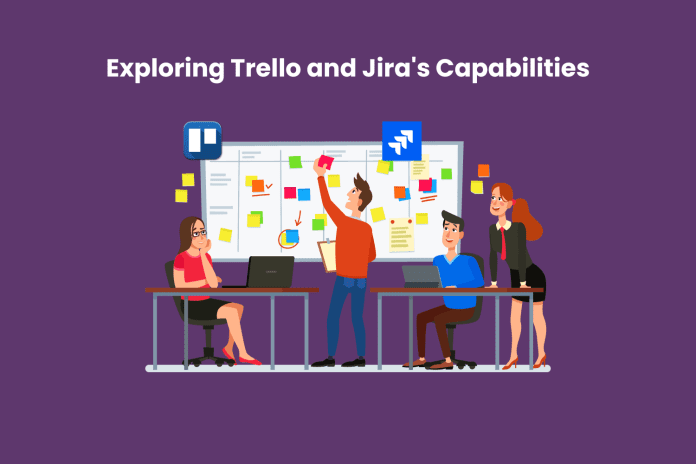Last Updated on November 29, 2023 by Asfa Rasheed
Two powerful applications, Trello and Jira, have constantly stood out among experts in the field of project management. These platforms, each with their own unique set of features and capabilities, have rapidly grown in prominence as vital tools for modern teams. Because of this, Jira Course has emerged as a game-changing resource for both individuals and businesses looking to gain a deeper understanding of and proficiency with Jira, the company’s popular project management software.
However, the decision between the project management tools Trello and Jira additionally increased in significance because of the impact it might have on productivity and results. Hence, this article compares the two platforms extensively through the prism of Trello vs Jira.
Table of Contents
Understanding Trello
Trello’s user-friendly interface and intuitive design have helped it to gather a substantial user base due to its accessibility and simplicity of use. By employing the platform’s fundamental concepts of boards, lists, and cards, teams can efficiently arrange work and communicate. Boards serve as the primary holding areas for projects or initiatives, while lists and cards aid workflow visualisation by dividing work into smaller, easier-to-manage portions.
Collaboration is at the heart of Trello’s design. Team members may attach files, write checklists, put notes on cards, set deadlines, and encourage real-time communication to ensure that everyone is on the same page. Furthermore, Trello offers an extensive array of customisation choices and connectors, enabling users to tailor the platform to their own needs. Trello is flexible enough to meet a variety of project requirements, ranging from third-party software connections to power-ups that enhance functionality.
Understanding Jira
Jira workflows may be tailored to each project’s unique requirements, providing a seamless transition from one stage to the next. Agile boards, which provide a visual depiction of work, assist teams in efficiently adopting agile methodologies such as Scrum and Kanban.
One of Jira’s most significant features is its sophisticated issue-tracking system. Teams may create tasks, prioritise them, allocate them, handle difficulties and track progress to ensure nothing falls through gaps. Furthermore, Jira’s robust reporting and analytics capabilities help businesses get valuable insights from their data. Customisable dashboards, comprehensive reporting, and real-time analytics allow data-driven decision-making, increasing project visibility and accountability.
Comparing Trello and Jira
To conclude, it is essential to compare the features, scalability, and suitability for specific project needs of Jira vs. Trello.
User interface simplicity
Trello stands out for its aesthetically beautiful user interface (UI) thanks to its boards, lists, and cards. Trello is a great option for small to medium-sized projects and teams because of its very user-friendly UI. Tasks are represented as cards, which provide a summary and simple drag-and-drop functionality. Its straightforward design ensures that novice users pick up on its functions fast, facilitating speedy team adoption.
Conversely, Jira offers a more robust and customisable user interface. Its flexibility allows for intricate processes and thorough problem monitoring. Jira’s user interface (UI) may seem confusing at first, yet it provides unparalleled customisation possibilities and intricacy. Because of Jira’s ability to adjust to intricate project structures and distinct business procedures, bigger teams and businesses find it to be an excellent choice for projects with a lot of needs.
Scalability and Complexity
Jira is a formidable tool when it comes to project management tool scalability. Because of its versatility, ability to manage large-scale projects, and extensive customisation options, it is the preferred option for organisations and complicated projects. Because of its adaptability, Jira can change with businesses and meet evolving project needs without compromising efficiency. Conversely, Trello excels in terms of ease of use and quickness. Although it isn’t as feature rich as Jira, its user-friendly interface makes it perfect for teams working on modest projects, startups, and small businesses. Trello’s power is in how fast and efficiently it can be set up, enabling teams to get going without a steep learning curve.
Flexibility and Customisation of the Project
The choice between Jira and Trello is also influenced by the required degree of project flexibility. Trello’s well-established framework, based on cards, lists, and boards, makes project management easier. It is less versatile than Jira, even if it offers some customisation possibilities via power-ups and integrations.
Teams can tailor Jira to their processes thanks to the platform’s many customisation options. Permissions, data, issue types, and custom procedures may all be changed to suit the requirements of a particular project. Jira’s exceptional customizability makes it an excellent alternative for projects with several teams, intricate workflows, and specialised procedures.
Integration of Ecosystems
Both Jira and Trello provide strong integration options that enable seamless interaction with a wide variety of other apps. With Trello’s Power-Up feature, users can quickly and effectively include well-known apps like GitHub, Google Drive, and Slack into the platform. Trello is now better equipped to satisfy a broader range of project needs thanks to these connections, which also enhance collaboration.
Conclusion
Whether it’s Trello’s streamlined simplicity or Jira’s multifaceted flexibility, each platform paves the way for effective project management, helping teams achieve their goals with precision and clarity.
















